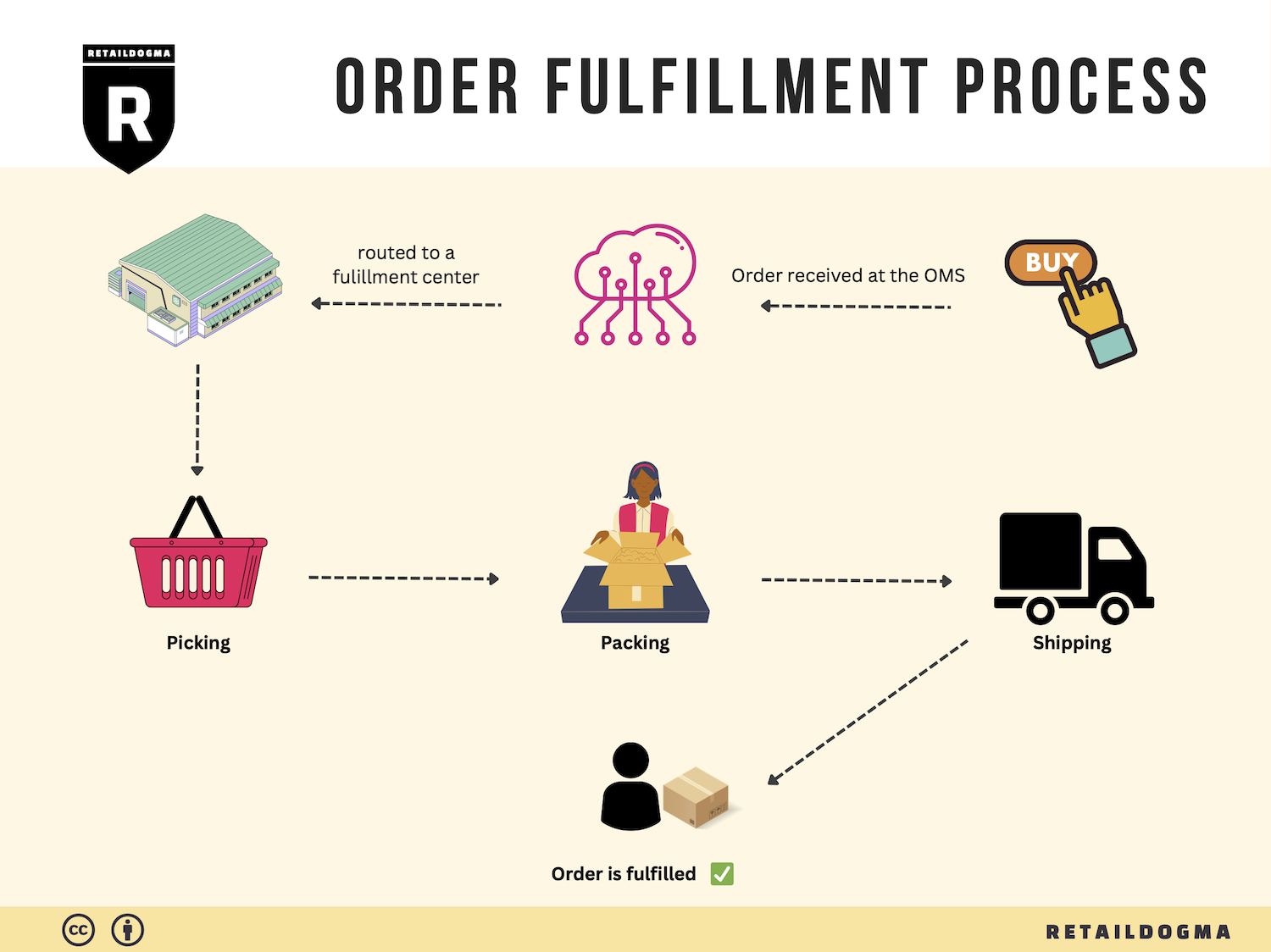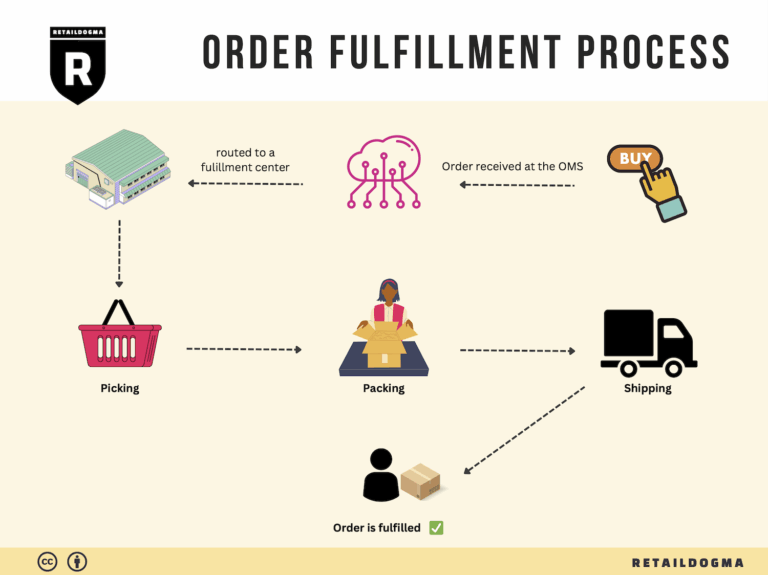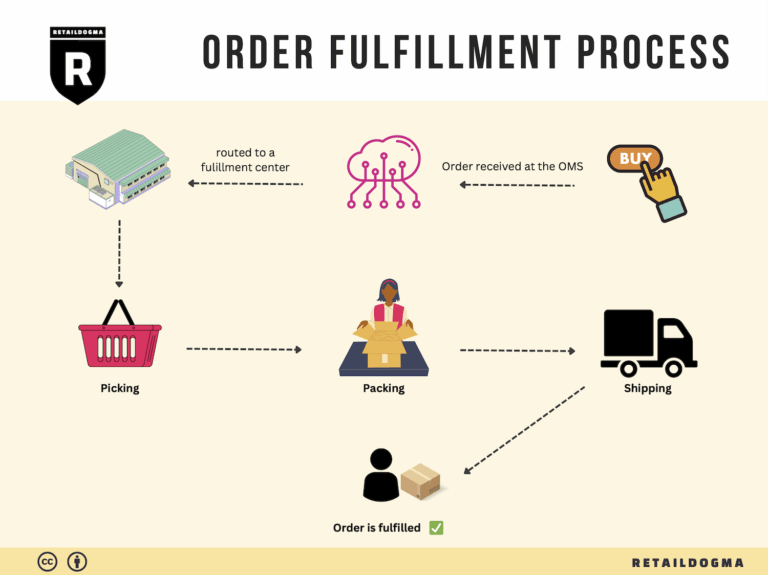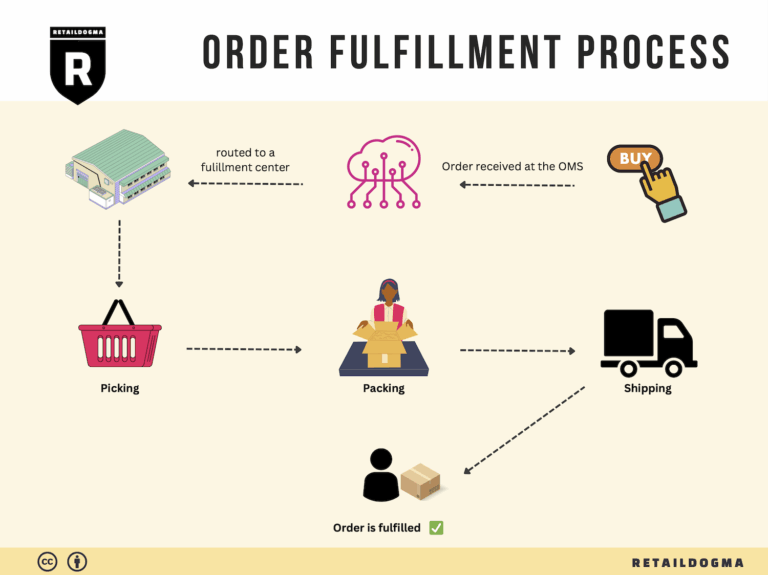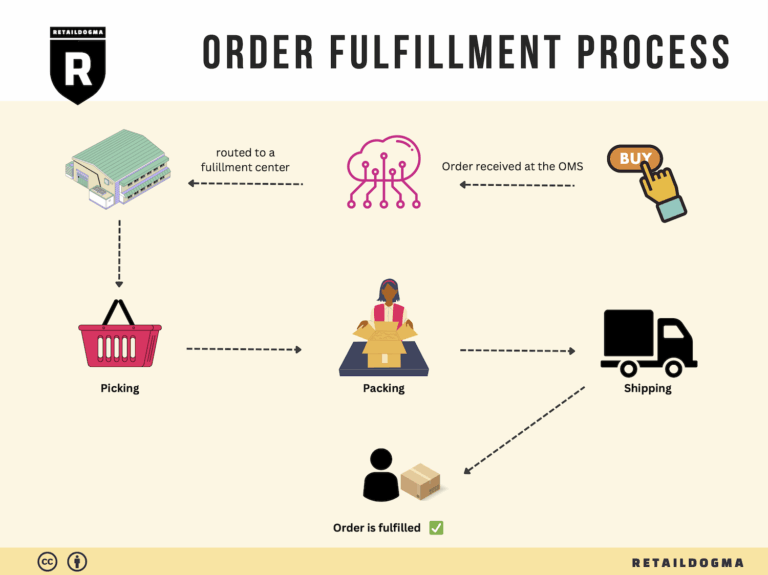How Order Fulfillment Works: A Step-by-Step Guide for Businesses
What is E-commerce Fulfillment? An Introduction for Growing Businesses
Understanding E-commerce Fulfillment: A Key to Your Growth
As an e-commerce business owner, you might often find yourself overwhelmed by the demands of packing and shipping orders. This stress can take away your focus from what truly matters—growing your business. Efficient order fulfillment is critical to your success; it involves every step of getting a product into the hands of your customers. From inventory management to shipping logistics, the fulfillment process can be complex, but it doesn’t have to be a burden.
Fulfillment is essentially the backbone of e-commerce—it encompasses the entire logistics process, including inventory storage, order processing, picking, packing, and shipping. For growing businesses, understanding and optimizing fulfillment is vital to enhancing customer satisfaction and sustaining growth.
In this guide, we will explore the various models available for e-commerce fulfillment, including Fulfillment by Amazon (FBA) and third-party logistics (3PL). Each model has its unique benefits and challenges, and knowing which one suits your business can significantly impact your operational efficiency and customer experience.
Core Services of E-commerce Fulfillment
We will delve into the core services offered by fulfillment centers, such as inventory management, returns processing, and customer service. These services not only streamline your operations but also ensure that your customers receive their orders quickly and accurately, which is crucial for building loyalty and repeat business.
Choosing the Right Fulfillment Partner
Selecting the right fulfillment partner is another critical aspect we will discuss. Factors such as scalability, technology integration, and service levels can vary widely among providers. We’ll provide you with a framework to evaluate potential partners, ensuring you find one that aligns with your business needs and growth objectives.
Pricing Models
Finally, we will address pricing considerations in fulfillment. Understanding the cost structures involved—whether it’s per order, storage fees, or shipping costs—will enable you to budget effectively and avoid unexpected expenses.
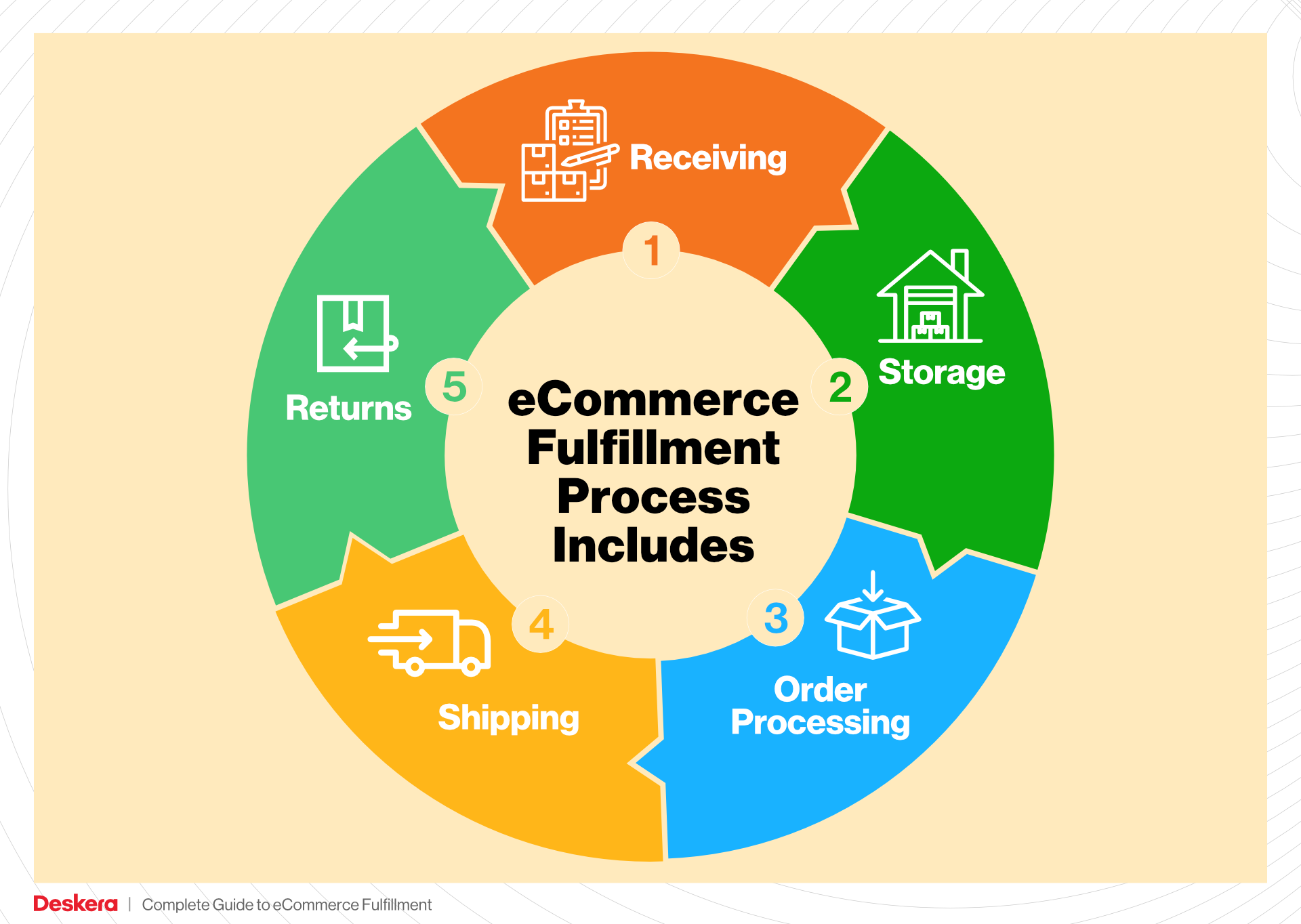
Empowering Your Business Decisions
The goal of this guide is to empower you to make informed decisions about your logistics strategy. By understanding e-commerce fulfillment’s intricacies, you can optimize your operations, enhance customer satisfaction, and ultimately scale your business successfully. With the right knowledge and partners, you can transform fulfillment from a daunting task into a strategic advantage.
What You’ll Learn In This Guide
- What is E-commerce Fulfillment? An Introduction for Growing Businesses
- The Order Fulfillment Process: From ‘Buy’ Button to Customer’s Door
- Comparing Fulfillment Models: In-House vs. 3PL vs. Dropshipping
- A Deep Dive into Amazon FBA: Pros, Cons, and Who It’s For
- Core Services Offered by Fulfillment Centers
- How to Choose a Fulfillment Partner: A 6-Point Checklist
- Understanding Fulfillment Pricing: A Breakdown of Common Fees
- Frequently Asked Questions (FAQs) about Fulfillment
- Conclusion: Is Outsourcing Fulfillment the Right Move for Your Business?
- Important Disclaimer
The Order Fulfillment Process: From ‘Buy’ Button to Customer’s Door
1. Receiving Inventory
The first step in the order fulfillment process is receiving inventory. This involves the acceptance of products from suppliers or manufacturers into the fulfillment center. Upon arrival, each shipment is verified against purchase orders to ensure accuracy in quantity and product type. Key terms associated with this step include SKU (Stock Keeping Unit), which is a unique identifier for each product that helps track inventory levels.
Receiving inventory is crucial because it lays the foundation for the entire fulfillment process. Accurate receiving ensures that the correct products are available for order fulfillment, reducing the risk of stockouts or incorrect shipments. Additionally, thorough inspection during this stage can help identify any damage or discrepancies that need to be addressed before products are stored.
2. Warehouse Storage
After inventory is received and verified, the next step is warehouse storage. This process involves organizing products within the fulfillment center in a manner that optimizes space and facilitates efficient order picking. Products are typically stored based on their SKU numbers, with similar items grouped together to enhance retrieval speed.
Effective warehouse storage is vital for several reasons. It not only maximizes the use of available space but also minimizes the time required to locate items during order picking. A well-structured storage system helps maintain inventory accuracy and can significantly reduce operational costs. FIFO (First In, First Out) is a common inventory management technique used during this phase, ensuring that older stock is sold before newer stock, which is particularly important for perishable goods.
3. Order Picking
Once an order is placed through the e-commerce platform, the next step is order picking. This is the process of retrieving the items specified in the customer’s order from the warehouse. Order picking can be done using various methods, such as single-order picking, batch picking, or zone picking. A pick list is generated for each order, detailing the items to be collected, their locations, and quantities.
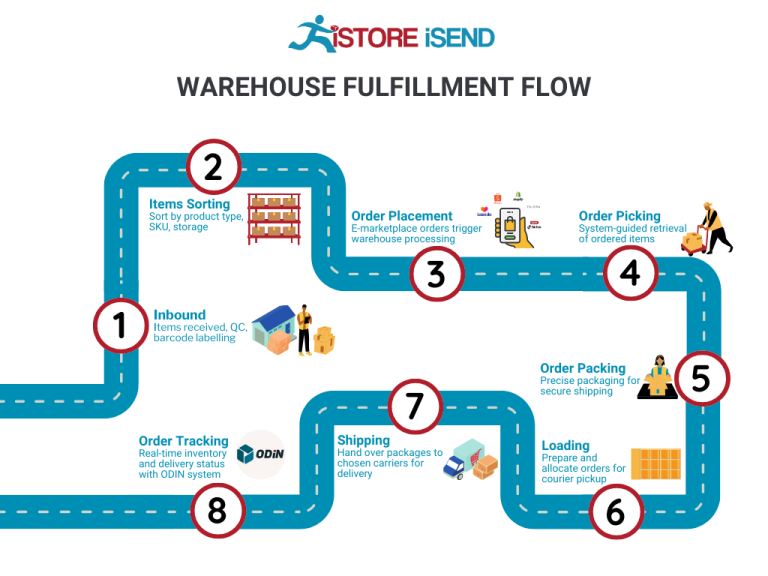
Order picking is a critical component of the fulfillment process as it directly impacts delivery speed and accuracy. Efficient picking methods can significantly reduce the time from order placement to shipment, enhancing customer satisfaction. Additionally, utilizing technology, such as barcode scanners or pick-to-light systems, can streamline this process, reducing human error and improving operational efficiency.
4. Order Packing
After the items have been picked, they move to the packing stage. In this step, products are carefully packed into boxes or containers, ensuring they are secure and well-protected for shipping. Packing materials, such as bubble wrap, packing peanuts, or custom inserts, may be used to prevent damage during transit. Key terms associated with this step include packaging specifications, which outline the requirements for packaging based on product type and shipping method.
Order packing is essential for several reasons. Proper packing not only protects the products but also reflects the brand’s commitment to quality and customer service. Additionally, efficient packing can help reduce shipping costs by optimizing box sizes and weight. This stage also includes labeling the packages with shipping information and tracking numbers, which is crucial for maintaining visibility throughout the delivery process.
5. Shipping & Delivery
The final step in the order fulfillment process is shipping and delivery. Once packages are packed and labeled, they are handed off to shipping carriers for delivery to the customer. This may involve various shipping options, including standard, expedited, or same-day delivery, depending on the service level chosen by the customer. Carrier management is a key aspect here, as businesses often negotiate contracts with multiple shipping providers to optimize costs and delivery times.
Shipping and delivery are the culmination of the entire fulfillment process, making them vital for customer satisfaction. Timely and accurate delivery can enhance customer loyalty and promote repeat purchases. Additionally, businesses should implement a robust tracking system that allows customers to monitor their orders in real-time, providing transparency and improving the overall shopping experience. Effective management of this final step can significantly impact a business’s reputation and bottom line.
By understanding and optimizing each of these steps in the order fulfillment process, e-commerce businesses can enhance efficiency, reduce costs, and improve customer satisfaction, ultimately leading to scalable growth.
Comparing Fulfillment Models: In-House vs. 3PL vs. Dropshipping
Fulfillment Model Comparison Table
| Model | Who Handles Inventory | Best For (Business Stage) | Key Advantage | Key Disadvantage |
|---|---|---|---|---|
| In-House Fulfillment | The business itself | Startups to mid-sized companies | Full control over inventory and operations | High overhead costs and resource demands |
| Third-Party Logistics (3PL) | External fulfillment provider | Established businesses scaling up | Cost savings and faster shipping times | Less control over inventory and processes |
| Dropshipping | Suppliers | Startups and small businesses | Low startup costs and no inventory risk | Lower profit margins and longer shipping times |
In-House Fulfillment
In-house fulfillment involves managing the entire logistics process within your own facilities. This model is typically favored by startups and mid-sized businesses that wish to maintain complete control over their inventory and operational processes. By handling storage, picking, packing, and shipping internally, businesses can tailor their fulfillment strategies to meet specific customer needs and quickly adapt to changing market demands. However, this model comes with significant overhead costs, including warehousing, labor, and equipment. Additionally, the resource demands can strain a business, particularly during peak seasons or when scaling operations. Thus, while in-house fulfillment can provide a competitive edge in terms of customization and control, it may not be sustainable for all businesses as they grow.
Third-Party Logistics (3PL)
Third-party logistics (3PL) refers to outsourcing fulfillment operations to an external provider. This model is ideal for established businesses looking to scale their operations without incurring the high overhead associated with in-house logistics. 3PL providers manage storage, order processing, and shipping, allowing businesses to focus on core activities such as marketing and product development. One of the primary advantages of 3PL is the cost savings associated with outsourcing logistics, as it eliminates the need for businesses to invest in warehouse space and staff. Additionally, 3PLs often have access to advanced technology and a network of distribution centers, resulting in faster shipping times and improved customer satisfaction. However, businesses may face challenges regarding the loss of control over inventory management and fulfillment processes, which can impact their ability to respond quickly to customer inquiries and demands.
Dropshipping
Dropshipping is a fulfillment model where the retailer does not keep products in stock but instead transfers customer orders directly to a supplier or manufacturer, who then ships the products to the customer. This model is particularly attractive for startups and small businesses with limited capital, as it requires minimal upfront investment and eliminates the need for inventory management. With dropshipping, businesses can offer a wide variety of products without the financial risk associated with holding inventory. However, this model comes with its own set of challenges, such as lower profit margins due to reliance on suppliers and potentially longer shipping times, which can affect customer satisfaction. Additionally, retailers have less control over product quality and fulfillment speed, as they depend on third-party suppliers to meet customer expectations. As a result, while dropshipping can be a viable entry point into e-commerce, it may not be the best long-term solution for businesses aiming for sustained growth and customer loyalty.
Conclusion
Choosing the right fulfillment model is crucial for e-commerce businesses looking to scale effectively. Each model—In-House Fulfillment, 3PL, and Dropshipping—offers distinct advantages and disadvantages that cater to different business stages and operational needs. Understanding these differences allows entrepreneurs and operations managers to make informed decisions that align with their growth strategies, customer expectations, and resource capabilities. As businesses evolve, they may also consider hybrid approaches, integrating aspects of each model to optimize their fulfillment processes and enhance overall efficiency.
A Deep Dive into Amazon FBA: Pros, Cons, and Who It’s For
Understanding Fulfillment by Amazon (FBA)
Fulfillment by Amazon (FBA) is a service that allows e-commerce sellers to leverage Amazon’s robust logistics and distribution network. When sellers use FBA, they send their products to Amazon’s fulfillment centers, where Amazon takes care of storage, packaging, and shipping to customers. This service enables sellers to focus on growing their businesses while Amazon handles the complexities of order fulfillment.
How FBA Works
-
Inventory Preparation: Sellers prepare their products according to Amazon’s guidelines, which include specific packaging, labeling, and product condition requirements.
-
Shipping to Amazon: Sellers ship their products to one or more of Amazon’s fulfillment centers. Amazon provides guidance on where to send inventory based on demand and geographical considerations.
-
Storage: Once received, products are stored in Amazon’s warehouses. Sellers can monitor their inventory levels through the Amazon Seller Central dashboard.
-
Order Processing: When a customer places an order for a product fulfilled by FBA, Amazon automatically processes the order. This includes picking the item from storage, packing it, and shipping it directly to the customer.
-
Customer Service and Returns: Amazon handles customer service inquiries and returns for FBA orders, providing a seamless experience for customers and reducing the operational burden on sellers.
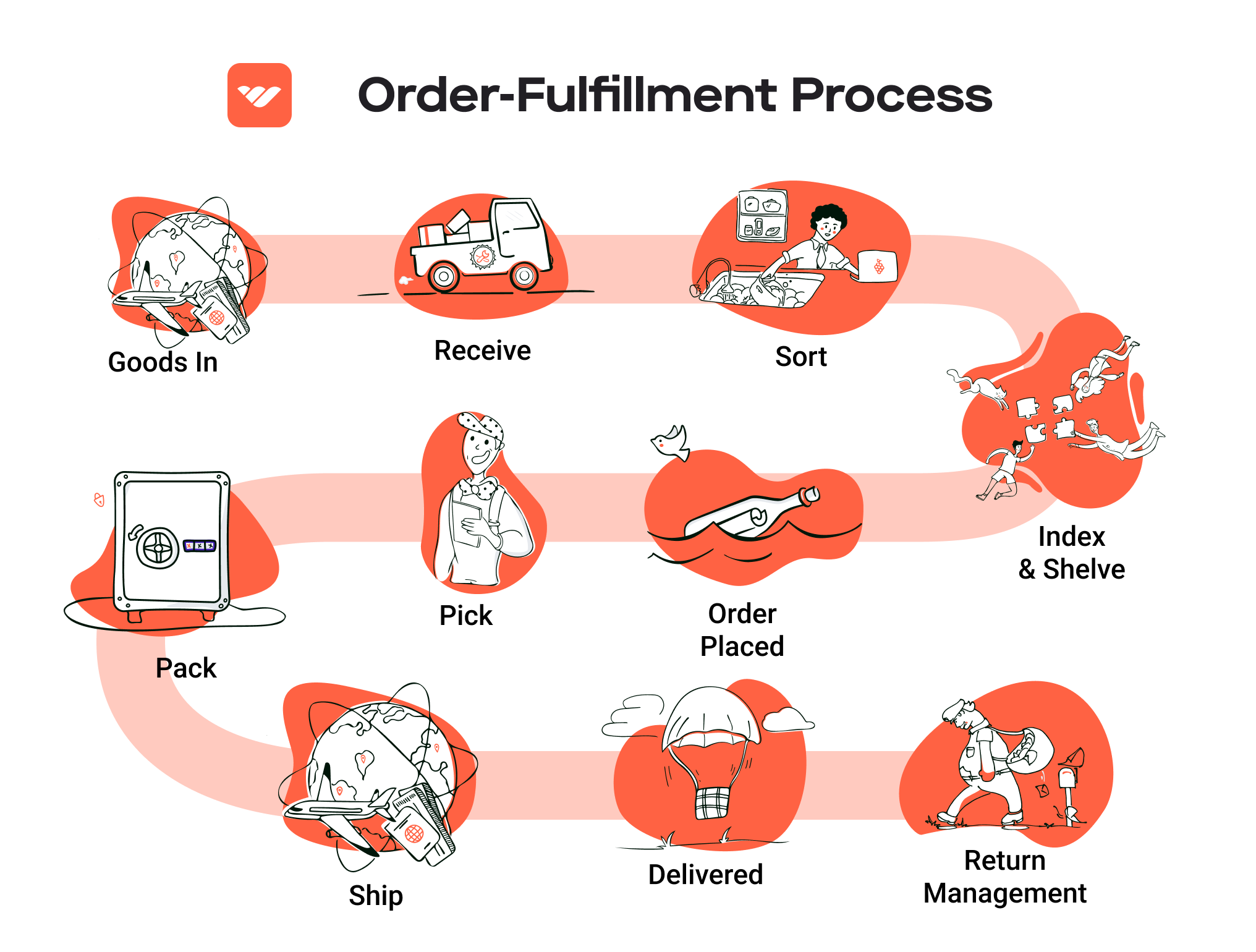
Pros of Fulfillment by Amazon
1. Prime Eligibility
One of the most significant advantages of FBA is that it qualifies products for Amazon Prime. This means products can be delivered to Prime members with the added benefits of faster shipping options, which significantly increases the likelihood of sales.
2. Enhanced Customer Trust
Selling through Amazon’s platform inherently builds customer trust. Customers are more likely to purchase from sellers whose products are fulfilled by Amazon due to the reliability and efficiency associated with the Amazon brand. This trust can lead to higher conversion rates.
3. Multi-Channel Fulfillment
FBA isn’t just limited to Amazon sales. Sellers can use FBA to fulfill orders from other platforms, such as their own e-commerce websites or eBay. This flexibility allows businesses to streamline their logistics by using a single fulfillment network across multiple sales channels.
4. Scalability
FBA allows businesses to scale quickly without the need for significant investments in warehousing or logistics infrastructure. As sales grow, sellers can simply send more inventory to Amazon’s fulfillment centers.
5. Access to Amazon’s Customer Service
With FBA, sellers benefit from Amazon’s dedicated customer service team, which handles inquiries and resolves issues related to orders, returns, and refunds. This service alleviates the need for sellers to manage customer support themselves.
Cons of Fulfillment by Amazon
1. High Fees
FBA comes with various fees, including storage fees for inventory held in Amazon warehouses and fulfillment fees for each unit sold. These costs can add up, particularly for sellers with low-margin products or those who maintain a large inventory.
2. Strict Inventory Rules
Amazon has stringent guidelines regarding inventory management. Sellers must adhere to these rules regarding product preparation, labeling, and storage. Non-compliance can lead to penalties or even suspension of selling privileges.
3. Commingling Risks
FBA operates on a commingling model, meaning that inventory from multiple sellers may be stored together. This can pose risks if products are damaged or if customers receive the wrong items. Sellers are responsible for ensuring their products meet Amazon’s standards to minimize these risks.
4. Limited Control Over Fulfillment
When using FBA, sellers relinquish some control over the fulfillment process. This includes aspects like packaging and shipping methods, which might not align with a seller’s brand image or customer expectations.
5. Seasonal and Long-Term Storage Fees
Sellers are charged long-term storage fees for products that remain in Amazon’s fulfillment centers for over six months. This can become a financial burden, particularly during off-peak seasons when inventory turnover is slower.
Who is FBA Best For?
Fulfillment by Amazon is particularly advantageous for sellers who:
-
Have High Sales Volume: Sellers with a high turnover of inventory can benefit from FBA’s efficiencies and reduced logistical burdens, enabling them to focus on scaling their businesses.
-
Sell Consumer Goods: Products that appeal to a broad audience and are eligible for Prime can see significant sales boosts through FBA due to increased visibility and trust.
-
Desire to Streamline Operations: E-commerce businesses looking to simplify their logistics and customer service processes can greatly benefit from FBA’s comprehensive solutions.
-
Are Ready to Invest in Fulfillment: Sellers who can absorb FBA’s fees and are willing to comply with Amazon’s strict guidelines will find that the benefits often outweigh the costs.
-
Plan to Expand Across Channels: Businesses that intend to sell on multiple platforms can leverage FBA for efficient order fulfillment across various sales channels.
In conclusion, while Fulfillment by Amazon offers numerous advantages such as increased sales potential and operational efficiency, it also comes with its share of challenges. Sellers must weigh the pros and cons carefully to determine if FBA aligns with their business goals and operational capabilities.
Core Services Offered by Fulfillment Centers
Inventory Management & Warehousing
Inventory management and warehousing form the backbone of any successful e-commerce operation. Fulfillment centers are equipped with sophisticated inventory management systems that enable businesses to track stock levels in real-time. This involves not only storing goods but also organizing them in a manner that optimizes picking efficiency and minimizes storage costs.
Benefits:
1. Real-Time Visibility: Businesses gain complete visibility into their inventory levels, allowing for more accurate forecasting and demand planning. This minimizes the risk of stockouts or overstock situations, which can lead to lost sales or increased holding costs.
-
Scalability: As e-commerce businesses grow, their inventory needs can fluctuate significantly. Fulfillment centers offer scalable solutions, enabling businesses to adjust their storage capacity without the overhead of maintaining their own warehouse.
-
Cost Efficiency: By outsourcing warehousing to fulfillment centers, businesses can reduce their fixed costs related to property leases, utilities, and labor associated with running a warehouse. This allows them to focus their resources on core business activities, such as marketing and product development.
Pick and Pack Services
Pick and pack services are critical in ensuring that orders are processed accurately and efficiently. This service involves selecting items from inventory based on customer orders, packaging them for shipment, and preparing them for delivery. Fulfillment centers utilize advanced technology and trained personnel to streamline this process.
Benefits:
1. Speed and Accuracy: Automated systems and well-defined processes reduce the time taken to fulfill orders while enhancing accuracy. This means customers receive the correct items quickly, improving customer satisfaction and retention.
-
Customization: Fulfillment centers often offer customizable packing options, such as branded packaging or gift wrapping. This allows e-commerce businesses to enhance their brand image and provide a more personalized customer experience.
-
Error Reduction: With advanced scanning technology and systematic procedures, fulfillment centers can significantly reduce the likelihood of errors in order fulfillment, which can lead to costly returns and customer dissatisfaction.
Kitting and Assembly
Kitting and assembly services involve grouping various items together to create a single product or package. This could range from assembling complex products to simply bundling items together for promotional offers. Fulfillment centers provide the labor and expertise required for these tasks, allowing businesses to offer value-added products without the need for in-house resources.
Benefits:
1. Enhanced Product Offerings: Businesses can create unique product bundles or kits that meet specific customer needs or seasonal demands, thereby increasing average order value and attracting new customers.
-
Time Savings: By outsourcing the kitting and assembly process, e-commerce businesses can save valuable time and resources. This allows them to focus on core competencies, such as product development and customer engagement.
-
Quality Control: Fulfillment centers typically have quality control measures in place to ensure that assembled products meet the required standards. This reduces the risk of defects and enhances customer satisfaction.
Returns Management (Reverse Logistics)
Returns management, or reverse logistics, is a crucial aspect of the fulfillment process, particularly for e-commerce businesses. Fulfillment centers handle the entire returns process, from receiving returned items to inspecting, restocking, or disposing of them as necessary.
Benefits:
1. Streamlined Process: Efficient returns management systems in fulfillment centers simplify the process for both the business and the customer. Automated processes ensure that returns are processed quickly, minimizing delays and enhancing customer satisfaction.
-
Cost Reduction: Managing returns in-house can be costly due to labor, storage, and transportation expenses. By outsourcing this function, businesses can significantly reduce these costs and improve their bottom line.
-
Data Insights: Fulfillment centers often provide detailed analytics on return reasons and trends. This information can be invaluable for businesses looking to improve product quality, customer service, or marketing strategies.
Conclusion
Engaging a fulfillment center for core services such as inventory management, pick and pack, kitting, and returns management can significantly enhance an e-commerce business’s operational efficiency. By leveraging the expertise and technology of fulfillment centers, businesses can streamline their logistics processes, reduce costs, and ultimately provide a superior customer experience. As e-commerce continues to evolve, these services will remain vital for businesses aiming to scale and succeed in a competitive marketplace.
How to Choose a Fulfillment Partner: A 6-Point Checklist
Location & Warehouse Network
Importance: The geographical location of your fulfillment partner’s warehouses significantly impacts shipping times and costs. A partner with strategically placed warehouses can reduce transit times, enhance customer satisfaction, and lower shipping expenses.
Questions to Ask:
– Where are your warehouses located, and how does that align with our target customer demographics?
– How do you ensure inventory is distributed across your network to minimize shipping delays?
– Do you have any international warehouses for global shipping needs?
Technology & Integrations
Importance: Modern e-commerce relies heavily on technology for order management, inventory tracking, and customer communication. A fulfillment partner with robust technology can streamline processes, reduce errors, and provide valuable insights into your operations.
Questions to Ask:
– What technology platform do you use for order management, and how does it integrate with our existing systems (e.g., Amazon Seller Central, Shopify)?
– Can you provide real-time tracking for orders, and how do you handle updates for customers?
– What reporting capabilities does your system offer, and can it help us analyze performance metrics?
Specializations (e.g., Cold Storage, Oversized Items)
Importance: Depending on the nature of your products, you may require specific services such as cold storage for perishables or specialized handling for oversized items. Choosing a partner with the right expertise can ensure compliance with regulations and product integrity.
Questions to Ask:
– What specific types of products do you specialize in handling?
– Do you have facilities equipped for temperature-sensitive items, and what are your compliance measures?
– How do you manage the storage and shipping of oversized or fragile products?
Scalability & Capacity
Importance: As your business grows, your fulfillment partner should be able to accommodate increased order volumes without compromising service quality. A partner with scalable solutions will help you manage seasonal spikes and long-term growth.
Questions to Ask:
– What is your current capacity, and how do you manage fluctuations in order volume?
– Can you provide case studies or examples of how you’ve supported other clients during peak seasons?
– What plans do you have in place for expanding your capacity in the future?
Pricing and Contracts
Importance: Understanding the pricing structure and contract terms is crucial for budgeting and avoiding unexpected costs. Transparent pricing will help you assess the true cost of fulfillment and ensure it aligns with your financial goals.
Questions to Ask:
– Can you provide a detailed breakdown of your pricing model (e.g., storage fees, pick and pack fees, shipping costs)?
– Are there any additional fees we should be aware of, such as for returns or special handling?
– What are the terms of your contract, and how flexible are they if our needs change?
Customer Support & Reviews
Importance: Exceptional customer support is vital for resolving issues quickly and maintaining smooth operations. Additionally, reviews and testimonials can provide insights into a partner’s reliability and service quality.
Questions to Ask:
– What customer support options do you offer (e.g., phone, email, live chat), and what are your response times?
– Can you provide references or case studies from current or past clients?
– How do you handle issues or complaints that arise during the fulfillment process?
Conclusion
Choosing the right fulfillment partner is a critical decision that can significantly affect your business’s operational efficiency and customer satisfaction. By using this checklist, e-commerce business owners, operations managers, and entrepreneurs can make informed decisions that align with their growth strategies and logistical needs. Evaluate each potential partner against these criteria to ensure they can meet your specific requirements and help your business scale successfully.
Understanding Fulfillment Pricing: A Breakdown of Common Fees
Initial Setup Fees
When partnering with a fulfillment center, the first cost to consider is the initial setup fee. This fee covers the onboarding process, including the integration of your e-commerce platform with the fulfillment center’s systems. It may also include the creation of a customized account, inventory setup, and the configuration of shipping parameters. Typically, these fees can range from a few hundred to several thousand dollars, depending on the complexity of your needs and the fulfillment provider’s capabilities.
To get a clear understanding of this fee, inquire about what is included in the setup process. Some fulfillment centers may bundle additional services such as training or initial inventory assessments, which could add value and justify the cost.
Receiving Fees
Receiving fees are charged when your inventory arrives at the fulfillment center. This fee covers the labor and resources required to unload, inspect, and store your products. The calculation is usually based on the volume of goods received, often measured in units or pallets. For instance, a fulfillment center might charge a flat fee per pallet or a variable fee based on the number of SKUs (stock-keeping units) processed during the receiving stage.
To minimize receiving fees, streamline your shipments to ensure that they arrive in bulk rather than as frequent small deliveries. This practice can help reduce the overall handling costs associated with receiving inventory.
Storage Fees (per pallet/bin)
Storage fees are recurring charges for the space your inventory occupies in the fulfillment center. These fees are typically calculated on a per-pallet or per-bin basis and are charged monthly. The cost may vary based on the specific location of the fulfillment center, as premium locations often command higher storage fees.
Understanding the type of storage fee structure is crucial. Some centers may offer tiered pricing, meaning the more pallets you store, the lower the rate per pallet becomes. Additionally, seasonal fluctuations can affect storage costs, so be prepared to adapt your inventory strategies accordingly.
Pick & Pack Fees (per item/order)
Pick and pack fees are charged for the labor involved in selecting items from inventory and preparing them for shipment. This fee is generally assessed on a per-item or per-order basis. The complexity of the order can also influence this fee; for instance, orders with multiple items may incur higher costs due to the additional labor required to gather and package the products.
To manage and potentially reduce pick and pack fees, consider consolidating orders or utilizing kitting services, where multiple items are packaged together into a single unit. This approach can optimize your fulfillment process and minimize costs.
Shipping Fees
Shipping fees represent one of the most significant costs associated with fulfillment. These fees cover the transportation of orders from the fulfillment center to the customer. Shipping costs can vary widely based on several factors, including the destination, the weight and dimensions of the package, and the chosen shipping method (standard vs. expedited).
Most fulfillment centers offer discounted shipping rates through partnerships with major carriers, which can help reduce overall shipping costs. Be sure to discuss shipping options and potential savings with your fulfillment provider, and consider implementing a strategy that balances speed and cost-effectiveness.
Tips for Getting an Accurate Quote
-
Provide Detailed Information: When requesting a quote, offer comprehensive details about your business needs, including average order volume, types of products, and anticipated seasonal fluctuations. This information helps fulfillment centers provide a more accurate estimate.
-
Compare Multiple Providers: Don’t settle for the first quote you receive. Compare offers from several fulfillment centers to ensure you understand the range of costs and services available.
-
Ask About Hidden Fees: Clarify any potential hidden fees that might not be included in the initial quote. This could encompass costs for returns, special handling, or additional services that may arise.
-
Request a Breakdown of Fees: A detailed breakdown of each fee type can help you understand the overall pricing structure and identify areas where you can optimize costs.
-
Negotiate: Don’t hesitate to negotiate terms and pricing. Many fulfillment centers are willing to offer discounts for long-term contracts or higher volume commitments.
By understanding these common fulfillment pricing models and following these tips, e-commerce businesses can effectively manage their logistics costs and scale operations efficiently.
Frequently Asked Questions (FAQs) about Fulfillment
1. What is the sny1 Amazon fulfillment warehouse?
The sny1 Amazon fulfillment warehouse is a facility designed to store, pick, pack, and ship products for sellers on Amazon. It serves as a critical component of Amazon’s logistics network, ensuring that orders are processed quickly and efficiently to meet customer demands.
2. What is the difference between a warehouse and a fulfillment center?
A warehouse is primarily a storage facility where goods are held for extended periods, usually for bulk inventory management. In contrast, a fulfillment center specializes in processing and shipping orders quickly, often handling a high volume of transactions and providing services like picking, packing, and returns management.
3. How does the fulfillment process work at the sny1 warehouse?
The fulfillment process at the sny1 warehouse typically involves several steps: inventory is received and stored, orders are placed by customers, the system automatically processes these orders, warehouse associates pick the items, pack them according to Amazon’s standards, and ship them out for delivery. This streamlined process is designed to ensure rapid order fulfillment.
4. What is a 3PL, and how does it relate to Amazon fulfillment?
A 3PL, or third-party logistics provider, is a company that offers logistics services to businesses, including storage, fulfillment, and shipping. For Amazon sellers, partnering with a 3PL can enhance fulfillment capabilities, allowing for greater flexibility, cost savings, and the ability to manage orders across multiple sales channels.
5. How much do fulfillment services cost?
Fulfillment service costs can vary widely based on factors such as order volume, storage space required, and specific services offered (like returns handling or custom packaging). Generally, costs include storage fees, picking and packing fees, and shipping charges. It’s best to request a quote based on your specific needs to get an accurate estimate.
6. Can I integrate my Amazon Seller account with the sny1 fulfillment warehouse?
Yes, you can integrate your Amazon Seller account with the sny1 fulfillment warehouse. This integration allows for seamless order processing, where orders placed on your Amazon store are automatically synced with the fulfillment system for efficient handling.
7. What are the benefits of using the sny1 fulfillment warehouse for my Amazon business?
Using the sny1 fulfillment warehouse offers several benefits, including faster shipping times, compliance with Amazon’s strict fulfillment requirements, reduced overhead costs by outsourcing logistics, and access to advanced fulfillment technology for real-time tracking and inventory management.
8. How do returns work with the sny1 fulfillment warehouse?
Returns are managed efficiently at the sny1 fulfillment warehouse. When customers return products, the warehouse team inspects the items and processes them according to your instructions—either restocking, refurbishing, or disposing of them. This service helps streamline your operations and maintain customer satisfaction.
9. Can the sny1 fulfillment warehouse handle seasonal demand fluctuations?
Yes, the sny1 fulfillment warehouse is equipped to handle seasonal demand fluctuations. With its scalable operations, you can adjust your inventory levels and fulfillment capacity based on peak seasons, ensuring that your business can meet increased customer demand without delays.
10. What support is available for transitioning from FBA to a 3PL model?
Transitioning from Fulfillment by Amazon (FBA) to a 3PL model, such as sny1, involves several steps. Support includes inventory transfer management, system integration assistance, and strategic advice to ensure minimal disruption to your operations and adherence to seller performance metrics throughout the transition.
Conclusion: Is Outsourcing Fulfillment the Right Move for Your Business?
Assessing the Value of Outsourcing Fulfillment
Outsourcing fulfillment can be a transformative decision for e-commerce businesses aiming to scale efficiently. One of the most compelling benefits is the significant time savings it offers. By partnering with a fulfillment service, you can redirect your focus from logistics to core business activities such as marketing, product development, and customer engagement. This shift not only enhances productivity but also allows for more strategic planning and execution.
Scalability is another crucial advantage. As your business grows, so too does the complexity of managing inventory, shipping, and customer service. Fulfillment partners provide the infrastructure and expertise needed to scale operations seamlessly. They can handle fluctuations in order volume, seasonal demands, and even international shipping, ensuring you maintain a high standard of service without the burden of extensive overhead.
Moreover, leveraging the expertise of fulfillment specialists means you gain access to best practices and advanced technologies that can optimize your logistics. From inventory management to compliance with marketplace requirements, a knowledgeable partner can help you navigate the complexities of e-commerce fulfillment, ensuring that your operations are both efficient and effective.
However, it is imperative to choose the right fulfillment partner. Not all services are created equal; the right fit will align with your business model, growth ambitions, and customer expectations. Conducting a thorough audit of your current shipping process can provide valuable insights into whether a fulfillment partner is the logical next step for your business.
In conclusion, if you’re looking to enhance efficiency, scalability, and expertise in your operations, outsourcing fulfillment might be the strategic move you need. Take the time to evaluate your current logistics setup and consider how a dedicated fulfillment service could accelerate your growth trajectory.
Important Disclaimer
⚠️ Important Disclaimer
The information in this guide is for educational purposes. Fulfillment services, pricing, and platform features change frequently. Always conduct your own due diligence and consult with providers directly before making business decisions.
